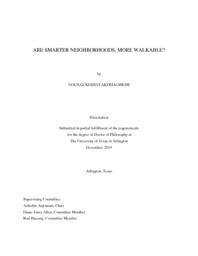
ATTENTION: The works hosted here are being migrated to a new repository that will consolidate resources, improve discoverability, and better show UTA's research impact on the global community. We will update authors as the migration progresses. Please see MavMatrix for more information.
Show simple item record
| dc.contributor.advisor | Anjomani, Ardeshir | |
| dc.creator | Keshavarzihaghighi, Golnaz | |
| dc.date.accessioned | 2022-02-10T17:29:21Z | |
| dc.date.available | 2022-02-10T17:29:21Z | |
| dc.date.created | 2019-12 | |
| dc.date.issued | 2019-12-06 | |
| dc.date.submitted | December 2019 | |
| dc.identifier.uri | http://hdl.handle.net/10106/30262 | |
| dc.description.abstract | This dissertation seeks to investigate the association between smart city initiatives and neighborhoods’ walkability. The preference for living in walkable neighborhoods has grown remarkably since 2017, in comparison to previous years, and residents of walkable neighborhoods show more satisfaction regarding their quality of life. In recent decades, people tend to live in communities that provide better QoL and are more receptive to their needs.
Meanwhile, with new technology advancements, residents and visitors have become more involved, and cities have become more responsive in recognizing their demands and providing solutions and services. Although technology plays a vital role in smart cities, not all services in a smart city are technology-based. Several of technology-based and non-technology-based characteristics come together to support the city’s performance and increase QoL for residents.
Urban design qualities and gross built environment characteristics are essential factors to support a neighborhood’s walkability. Several studies explored the relationship between neighborhood characteristics and pedestrian activity. This research aims to recognize the relationship between smart characteristics of the neighborhood and pedestrian activity as a gap in smart city and walkability literature. This research hypothesizes that a higher number of smart city characteristics associates with a higher number of pedestrians. It uses the mixed-method approach to test this hypothesis. The qualitative method identifies the study area and users’ perception of walkable neighborhoods. Urban design qualities, built environment characteristics, and neighborhood smartness score test the hypothesis in a Negative Binomial Regression Model. The number of pedestrians counted in each block face is the dependent variable in the study. Concurrent triangulation is used to combine the findings from qualitative and quantitative methods and interpret the findings. The results of this study confirm the hypothesis. There are several lessons in this study for urban planners, urban designers, policymakers and developers. | |
| dc.format.mimetype | application/pdf | |
| dc.language.iso | en_US | |
| dc.subject | Smart City, Walkable Neighborhood, Walkability, Pedestrian | |
| dc.title | Are smarter neighborhoods, more walkable? | |
| dc.type | Thesis | |
| dc.degree.department | Urban and Public Affairs | |
| dc.degree.name | Doctor of Philosophy in Urban Planning and Public Policy | |
| dc.date.updated | 2022-02-10T17:29:22Z | |
| thesis.degree.department | Urban and Public Affairs | |
| thesis.degree.grantor | The University of Texas at Arlington | |
| thesis.degree.level | Doctoral | |
| thesis.degree.name | Doctor of Philosophy in Urban Planning and Public Policy | |
| dc.type.material | text | |
| dc.creator.orcid | 0000-0002-3753-7886 | |
Files in this item
- Name:
- KESHAVARZI-DISSERTATION-2019.pdf
- Size:
- 4.078Mb
- Format:
- PDF
This item appears in the following Collection(s)
Show simple item record


